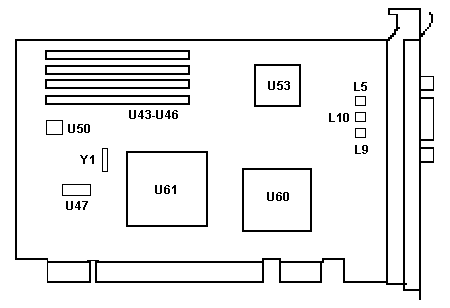|
IBM SVGA Adapter/A Driver
Disk It is also known as the ISO Display Adapter/A 39G3298 WBST said: Other test results are very appreciated since I could
test with the SVGA Adapter/A only. Be careful with
original IBM/PS2 tube monitors because a 800x600
resolution may damage them. IBM SVGA Adapter/A 256c SVGA /A Developments ADF Section IBM SVGA Adapter/A 
This puppy has 512K of VRAM. It is supported as
a generic SVGA adapter. The SVGA refers only to the
640x480 resolution, NOT color depth. NO specific Win xxx
drivers exist. Or for that matter, OS/2 (VGA256). SVGA /A Developments Wolfgang Gehl spake thusly: While playing with a Solaris setup on a 9595 I ended up creating a DOS partition and giving SVGA Adapter/A a try. This mysterious card currently has no OS support beside OS/2 with VGA resolution and 256 colors and VESA VBE support for DOS. First I tried the VESA driver from m95svga.exe. It offers VESA VBE 1.2 support for 256 colors for resolutions up to 800*600 pixels customized for the display's horizontal refresh rate. Since I use a LCD monitor, I disabled 640*400 and the 16 colors interlaced 1024*768 mode and choose 60Hz for 640*480 and 800*600 mode. Do you remember trying to play "Simcity 2000" or "The Settlers" with XGA/2? Never got it running. With SVGA/A and loaded VESA driver these games are playable without a hitch. It's kind of a crazy to play DOS SVGA games on a 9595 RAID5 Server, however, it works! Simcity 2k for DOS contains a VESA driver collection with an IBM directory. Inside are two VESA drivers. One is for XGA/XGA2 (for Simcity dysfunctional, LOL) the other one is for the PS/2 25SX planar video. A look at Williamís 25SX site shows that the SVGA/A chipset is sitting on the 25SX planar. And he mentions that it is common on 40SX and 56/57 SX/SLC planars too. A search for "IBM 84F7985" took me to a thread on a PS/1 forum with the title "The mystery of the PS/1 2121ís (S)VGA" https://ps1stuff.wordpress.com/2016/09/13/the-mistery-of-the-ps1-2121s-svga/ Obviously IBM used this chip in several x86 machines, and for us most important, inside the micro channel PS/2 ThinkPads too. A ThinkPad without Windows drivers is hard to imagine. And right, Louis has the 256 colors Windows 3.1 driver, which is in fact the 25SX_AND_700C_AND_720C display driver: http://ps-2.kev009.com/ohlandl/9552/9552_700C.html Since we have the driver, we have the chipset name too: IBMVGA256c Well, don't expect to much, the Windows 3.1x setup offers 256 colors for 640x480 pixels only. It works in conjunction with the DOS VESA VBE driver and seems to be an early if not the first Windows VESA VBE driver at all. I've tested with windows 3.1, 3.11, and 95. With 95 the 16bit driver slows down the system and there are severe incompatibilities e.g. with explorer.exe. Here is the incomplete information I could find so far: The IBMVGA256c chipset ====================== IBM PS/1 2121 [1] ------------- Year: 1991 (?) Video chipset: IBM 84F7985 (= TI CF62011BPC) IBMVGA256c RAM DAC: INMOS IMSG171P-35 [2] 35MHz 8 Bit DAC up to 256 colors from a total of 262,144 colors RAM: 256KB 100ns VRAM IBM PS/2 8540SX --------------- Year: 1991 Video chipset: IBMVGA256c (?) RAM DAC: ? RAM: ? IBM PS/2 8557SX [3] --------------- Year: 1991 Video chipset: IBM 84F7985 IBMVGA256c unknown: IBM 85F0120 RAM DAC: INMOS IMSG171P-50 [2] 50MHz 8 Bit DAC up to 256 colors from a total of 262,144 colors RAM: 512KB 80ns VRAM IBM PS/2 8525SX [4] --------------- Year: 1991 (?) Video chipset: IBM 84F7985 IBMVGA256c RAM DAC: INMOS IMSG171P [2] (?)MHz 8 Bit DAC up to 256 colors from a total of 262,144 colors RAM: 512KB 80ns VRAM IBM PS/2 Thinkpad 700C/720C [5] --------------------------- Year: 1992 Video chipset: IBM 39G8600 IBMVGA256c Clock chip: ICS ICS2494 [6] 135MHz Dual Video/Memory Clock Generator for VGA, Super VGA, XGA video adapters, 8514A, TMS34010, TMS34020 RAM DAC: ?MHz on chip? RAM: 512KB 80ns VRAM IBM SVGA Adapter/A [7] ------------------ Year: 1992 (together with Server 85) Video chipset: IBM 42G3410 (= TI CF63011PCM) IBMVGA256c unknown: IBM 85F0120 (= OKI M7U016-008) Clock chip: ICS ICS2494 [6] 135MHz Dual Video/Memory Clock Generator for VGA, Super VGA, XGA video adapters, 8514A, TMS34010, TMS34020 RAM DAC: INMOS IMSG176J-80Z [8] 80MHz 8 Bit DAC up to 256 colors from a total of 262,144 colors RAM: 512KB 80ns VRAM Driver Support -------------- DOS: generic: 700c120-exe [9] SVGA/A: m95svga.exe [10] VESA/VBE driver* 256KB VRAM, at least 40MHz RAM DAC 800x600 pixels, 16 colors, 60Hz** 512KB VRAM, at least 30MHz RAM DAC 640x480 pixels, 256 colors, 60Hz 512KB VRAM, at least 40MHz RAM DAC 800x600 pixels, 265 colors, 60Hz** 512KB VRAM, at least 50MHz RAM DAC 1024x768 pixels, 16 colors, 43Hz I*** 256KB VRAM, at least 30MHz RAM DAC 132-column x 25-row text * RAM DAC requirements are calculated with the formula line frequency in kHz = ([vertical resolution] * [horizontal refresh rate] Hz + [vertical resolution] * [horizontal refresh rate] Hz * 0,1)/1000 RAM DAC pixel frequency in MHz = ([horizontal resolution] * [line frequency] kHz + [horizontal resolution] * [line frequency] kHz *0,2)/1000 ** the IBMVGA256c chipset does 800x600 pixels, 56Hz too but LCDs usually don't support refresh rates below 60Hz and you will not accept a 56Hz refresh rate on aCRT monitor. *** LCDs usually don't support an interlaced video resolution. 1024x768 pixels,16 colors, 60Hz requires at least a 70MHz RAM DAC OS/2: from v2.11 up build in under the name "IBM VGA 256c" 640x480 pixels, 256 colors with 512KB VRAM, at least a 30MHz RAM DAC[11] Windows 3.1x: generic: 700c120-exe [9] 640x480 pixels, 256 colors w/ 512KB VRAM, at least a 30MHz RAM DAC together with DOS VESA/VBE software driver [1] https://ps1stuff.wordpress.com/2016/09/13/the-mistery-of-the-ps1-2121s-svga/ [2] IMSG171P is compatible to BT476: https://www.datasheetarchive.com/pdf/download.php?id=527994991358bc5dc0a9e619b66f0a2d71ba0d&type=O&term=IMSG171 BT47x circuit description: https://www.datasheetarchive.com/pdf/download.php?id=dd6f6622ae7025772fc684bf7840a63ab87fae&type=M&term=bt476 [3] http://ps-2.kev009.com/ohlandl/8557/8557SX-Planar.html [4] http://www.walshcomptech.com/ps2/25sx.htm [5] http://www.vgamuseum.info/images/vlask/ibm/39g8600f.jpg http://www.vgamuseum.info/images/vlask/ibm/39g8600fz.jpg [6] ftp://bitsavers.informatik.uni-stuttgart.de/pdf/integratedCircuitSystems/1994_Integrated_Circuit_Systems_Data_Book.pdf, pp. 161-165 [7] http://www.vgamuseum.info/images/palcal/ibm/44_ibm_fru_71f4877_top_hq.jpg [8] https://www.datasheetarchive.com/pdf/download.php?id=30c4f464de799e8bfcadd50feda3f34ef84d46&type=M&term=IMSG17 [9] http://ps-2.kev009.com/ohlandl/9552/r700c120.exe [10] http://ps-2.kev009.com/ohlandl/video/m95svga.exe [11] a higher resolution may be possible according to: http://www.edm2.com/index.php/DDDR/2_-_32-Bit_Super_VGA_Display_Driver
AdapterId 90EE SVGA Adapter/A FixedResources io 3b0h-3bbh 3c0h-3dfh int 9 Video I/O Address |